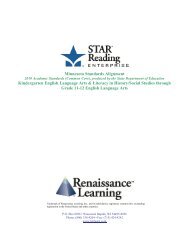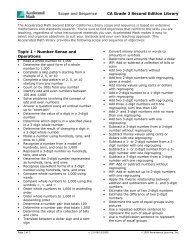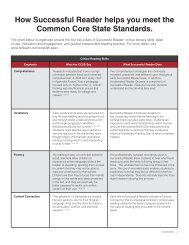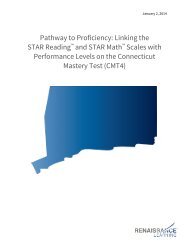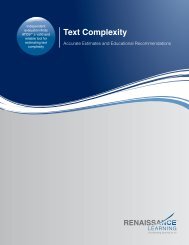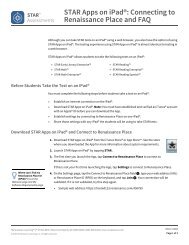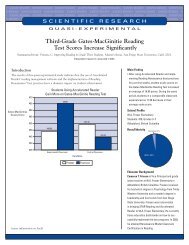Technical Manual - Renaissance Learning
Technical Manual - Renaissance Learning
Technical Manual - Renaissance Learning
You also want an ePaper? Increase the reach of your titles
YUMPU automatically turns print PDFs into web optimized ePapers that Google loves.
Score DefinitionsStudent Growth Percentile (Time-Adjusted Model) (SGP (TAM))Student Growth Percentile (Time-Adjusted Model) (SGP (TAM))Student Growth Percentile (Time-Adjusted Model) (SGP (TAM))s are anorm-referenced quantification of individual student growth derived usingquantile regression techniques. An SGP (TAM) compares a student’s growth to thatof his or her academic peers nationwide. SGP (TAM)s provide a measure of how astudent changed from one STAR testing window 17 to the next relative to otherstudents with similar starting STAR Early Literacy Enterprise scores. SGP (TAM)srange from 1–99 and interpretation is similar to that of Percentile Rank scores;lower numbers indicate lower relative growth and higher numbers show higherrelative growth. For example, an SGP (TAM) of 70 means that the student’s growthfrom one test to another exceeds the growth of 70% of students nationwide in thesame grade with a similar beginning (pretest) STAR Early Literacy Enterprise score.All students, no matter their starting STAR score, have an equal chance todemonstrate growth at any of the 99 percentiles.SGP (TAM)s are often used to indicate whether a student’s growth is more or lessthan can be expected. For example, without an SGP (TAM), a teacher would notknow if a Scaled Score increase of 100 represents good, not-so-good, or averagegrowth. This is because students of differing achievement levels in different gradesgrow at different rates relative to the STAR Early Literacy Enterprise scale. Forexample, a high-achieving second-grader grows at a different rate than alow-achieving second-grader. Similarly, a high-achieving second-grader grows ata different rate than a high-achieving eighth-grader. SGP (TAM) can be aggregatedto describe typical growth for groups of students—for example, a class, grade, orschool as a whole—by calculating the group’s median, or middle, growthpercentile. No matter how SGP (TAM)s are aggregated, whether at the class, grade,or school level, the statistic and its interpretation remain the same. For example, ifthe students in one class have a median SGP (TAM) of 62, that particular group ofstudents, on average, achieved higher growth than their academic peers.17. We collect data for our growth norms during three different time periods: fall, winter, and spring.More information about these time periods is provided on page 138.STAR Early Literacy<strong>Technical</strong> <strong>Manual</strong>113





